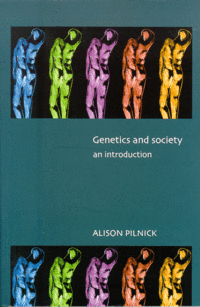

![]()
![]()

The main concern of chapter two is the historical context of the new genetics, and this involves a discussion of the eugenics movement in the last century. This is a good start to the book, as it clearly illustrates the point that scientific discoveries do not just exist as impartial facts, but are embedded in social and political issues. Tied up with this is a brief introduction to the sociology of science, which subsequent chapters return to in various ways. Chapter three considers the important potential implications of finding a gene for aggression, alcoholism, homosexuality and/or intelligence. Pilnick focuses on work on heredity and intelligence, highlighting that research of this sort has historically been linked to political movements and concerns, and demonstrates that this situation remains to the present day.
Antenatal screening is used as the case study in chapter four to make the important point that even though this is an individual choice in principle, it is embedded in discourses of maternal responsibility that limit the amount of freedom that the woman has. Further, as Pilnick notes, routine antenatal screening has important implications for the social construction of risk and of disability. Sociological concerns associated with medical confidentiality, insurance and informed consent are illustrated through a discussion of genetic testing in chapter five. The scope of the book only allows for a brief summary, which means that some significant issues about, for example, informed consent, are not included. However, in place of these aspects of consent, Pilnick manages to consider issues in genetic counselling, such as non-directiveness, and through this emphasises the need to be aware of individual views in consideration of the uptake of genetic technologies.
Chapter six addresses how the findings of the Human Genome Project have been managed, and considers how major interest groups have negotiated issues of patenting and intellectual property rights. Pilnick also gives a summary of the applications of this knowledge about the human genome, focusing on the practical and ethical issues in gene therapy, pharmacogenetics, and DNA biobanks.
In chapters seven and eight, the author looks at genetically modified foods and cloning respectively, both of which are genetic technologies to which the public has reacted negatively. The book emphasises the importance of understanding these reactions in their broad social context: the social construction of food and the unfamiliarity of a new technique respectively. The role of the media in shaping public perceptions is highlighted in respect of both these technologies.
Chapter nine, contributed by Robert Dingwall, is a good introduction to bioethics for sociologists. It discusses the benefits and complexities of applying bioethical principles to issues in the new genetics, but, consistent with the themes of the book, also locates the contemporary concern with ethical issues within a broader social and political context.
The final chapter considers the future of genetic research, discussing the importance of developing regulatory frameworks that allow the benefits of genetic technologies to be felt, while limiting the disadvantages. It emphasises that the deployment of these technologies should always be regarded with their potential social and political implications in mind. This argument is widely accepted; the book's real value lies in its emphasis on the social issues and concerns that are linked to the development of these technologies.
In sum, this book is a good introduction to sociological interests in the new genetics, in that it describes a variety of issues and highlights the complexities of the research area. Depth of analysis is sacrificed for breadth of subjects covered, and in some cases this is frustrating, as some of the more interesting issues are omitted. Also, the move between different topics is confusing at times as the author tries to cover the various concerns raised by a particular case study. However, there is a need for a good introductory textbook to genetics and society, and this book fulfils this requirement very well. I would recommend this book as a starting point for those who are interested in sociology and the new genetics, and for those already in the field who are interested in the broader context of these new technologies.
Georgina Haarhoff
Centre for Family Research, University of Cambridge
